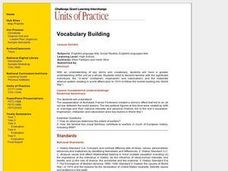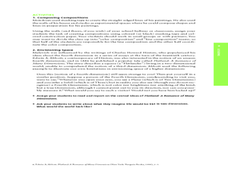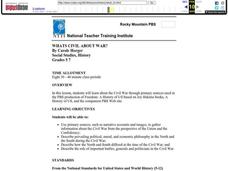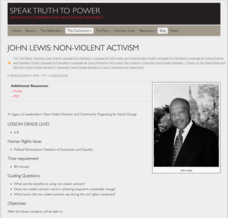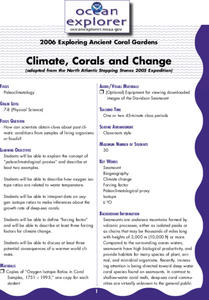Curated OER
A Day of Infamy:Analyzing FDR’s Pearl Harbor Address
In 1941 FDR spoke out on the events at Pearl Harbor. The class will get to analyze word choice, word meaning, author's craft and structure by analyzing an actual draft of this speech. They will look critically at the words used,...
Museum of Tolerance
Developing Media Literacy
To protect young people from questionable content, many schools limit access. This resource suggests that because learners can so readily avail themselves to unrestricted Internet access, it is vital for 21st century learners to develop...
Prairie Public Broadcasting
Egyptian Pyramids Virtual Field Trip!
A virtual field trip takes enthusiastic travelers to the pyramids of Giza. Using Google, scholars explore the grounds of the ancient pyramids found in Egypt then complete three worksheets: a photo analysis page, a reflection sheet, and a...
American Battlefield Trust
Antietam 360
It was the single bloodiest day in Civil War history. Now, class members have the opportunity to walk in the footsteps of soldiers who fought in the Battle of Antietam using an interactive website. Supplemental resources include...
Curated OER
Coal Mine Industrial Picture Analysis
Learners observe coal mine pictures. In this US history lesson, students analyze the pictures realizing that history is shown in pictures and then write a newspaper article about life in a coal town using the pictures as sources of...
Curated OER
Impact of War with Asia on Asian Americans Angel Island
High schoolers identify perceptions towards Asians widely held by the American public through the analysis of political cartoons from the 1940's and 1990's. They recognize the ramifications of such perceptions on Asians and Asian Americans.
Curated OER
Mapping Perceptions of China
Students discuss what types of things are included on a map. They compare and contrast maps of China with a map they create and practice using different types of maps. They write analysis of their classmates maps.
Curated OER
Urban Ecosystems 2: Why are There Cities? A Historical Perspective
Second in a series of five lessons, this lesson encourages preteens to consider cities as urban ecosystems. First, they keep a food diary for a few days. They visit the Natrional Agricultural Statistics Service website for current data...
Curated OER
World War II: America on the Home Front
Eleventh graders gain a sense of historical time and historical perspective as they study the massive campaign that the U.S. government launched to convince Americans to conserve, participate, and sacrifice. They study cencorship, and...
Curated OER
Analysis of Character in a Short Story
Ninth graders examine a character from the short story, John Steinbeck's, "Flight." students respond to questions about the story and illustrate the character's journey.
Curated OER
Vocabulary Building - World War I
Students study the definitions of militarism, imperialism, and nationalism, and the significant individuals involved in the world alliance system prior to 1914. They examine the events that lead to World War I.
Curated OER
Art or Artifact?
High schoolers analyze and discuss illustrations of the New World by John White. They examine the images, answer questions about each one, and write an essay.
Curated OER
New Visions of the World
Students explore the art of Kazimir Malevich and Piet Mondrian as an analysis of abstract painting. In this abstract painting lesson, students explore the painting style of the two artists. Students analyze the use of shape, line,...
Curated OER
Sow the Seeds of Victory! Posters from the Food Administration During World War I
Students engage in a class analysis of posters, responding to each of the worksheet questions. They identify the similarities and differences between the posters.
Curated OER
World War II Memories
Fifth graders utilize primary sources provided to formulate questions to prepare for an interview. Veterans and civilians who lived during World War II are interviewed by students and their work displayed on a web site.
Curated OER
What's Civil About War?
Students study about the Civil War through primary sources used in the PBS production of "Freedom: A History of US" based on Joy Hakim's books, "A History of US", and the companion PBS Web site.
Curated OER
Inca's Untangles World
Students read a reprinted article from USA Today. In this metacognition lesson, students complete a worksheet about their thoughts while they are reading.
Curated OER
The Effects of Slavery
The emotional and spiritual oppression of slavery in the African-American experience is the focus of this lesson. Middle schoolers analyze various texts by Frederick Douglass and Maya Angelou related to freedom and oppression. They use...
Curated OER
Teaching With Documents Lesson Plan: "A Date Which Will Live in Infamy"
Your class examines F.D.R.'s speech for examples of repetition, alliteration, emotionally charged words, etc. They listen to the speech and interview a person who heard it delivered. They finish by writing an article about the experience.
Curated OER
Come Fly with Me . . . Open a Book: Travels through Literature
This detailed overview of a curriculum unit suggests using travel literature to engage and stimulate your third graders’ interest in reading. The suggested reading list includes fiction and non-fiction materials and offers urban children...
Speak Truth to Power
John Lewis: Non-Violent Activism
After comparing and contrasting non-violent and violent social movements, your young historians will take a closer look at the work and influence of John Lewis on the civil rights movement. They will then choose a current social justice...
NOAA
Climate, Corals and Change
Global warming isn't just an issue on land; deep ocean waters are also showing troubling signs. Young scientists learn more about deep water corals and the many recent discoveries researchers have made. Then they examine data related to...
Curated OER
Using Primary Sources to Study the Holocaust
Engage your middle schoolers with Pastor Martin Niemoller's famous poem that begins, "First they came for the communists." Now that you have their attention, send learners to the various work stations you created to have them explore...
Curated OER
Introduction to Age of Absolutism
Who were the absolute monarchs of Europe and what effect did they have on their countries? Young historians begin by naming qualities they believe are important for a monarch to possess. They then take notes on four key factors leading...












